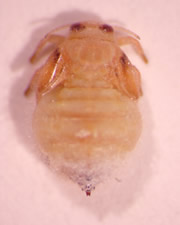Hackberry petiole gall psyllid (Pachypsylla venusta)
 Hackberry petiole gall psyllid Image source: Daniel Sloan |
Contact: Daniel Sloan
Researchers involved: 20
Size (or size of nearest relative): 724 MBp
Keywords (and why important): Novel Chemistry, Novel Metabolic Process, (model organism).
Pachypyslla venusta is a gall-forming psyllid (Insecta: Hemiptera) specializing on hackberry trees, which are widely distributed in the United States.
Like many closely-related hemipterans such as whiteflies, aphids, and mealybugs, psyllids have a nutritionally imbalanced diet consisting primarily of plant sap. To compensate for the paucity of essential amino acids and other required nutrients in their diets, these insects have evolved ancient and intimate symbiotic relationships with intracellular bacteria that are capable of synthesizing these compounds.
The genome of the bacterial symbiont Carsonella from Pachypyslla venusta has been sequenced and represents one of the most extreme cases of genome reduction ever identified. At only 160 kb in size, this bacterial genome lacks many genes thought to be essential for cellular life, making this system an important model for elucidating the genomic mechanisms of host-symbiont interactions.
A complete genome from this gall-forming psyllid will also provide a valuable resource for investigating plant-insect interactions and gall-induction.
Genomic Resources
For the most current version of the assembly, please use 'NCBI BioProject' (find link below). If the assembly is unavailable in the BioProject page (it is still being worked on), you can look under the 'BCM-HGSC data' (find link below) for intermediate versions of the assembly.
Web Apollo: A web-based sequence annotation editor for community annotation
For information about Web Apollo, please contact Monica Poelchau.
-
Web Apollo annotation tool (requires log in)
-
Web Apollo Jbrowse viewing of the automated annotation tracks (no log in required)